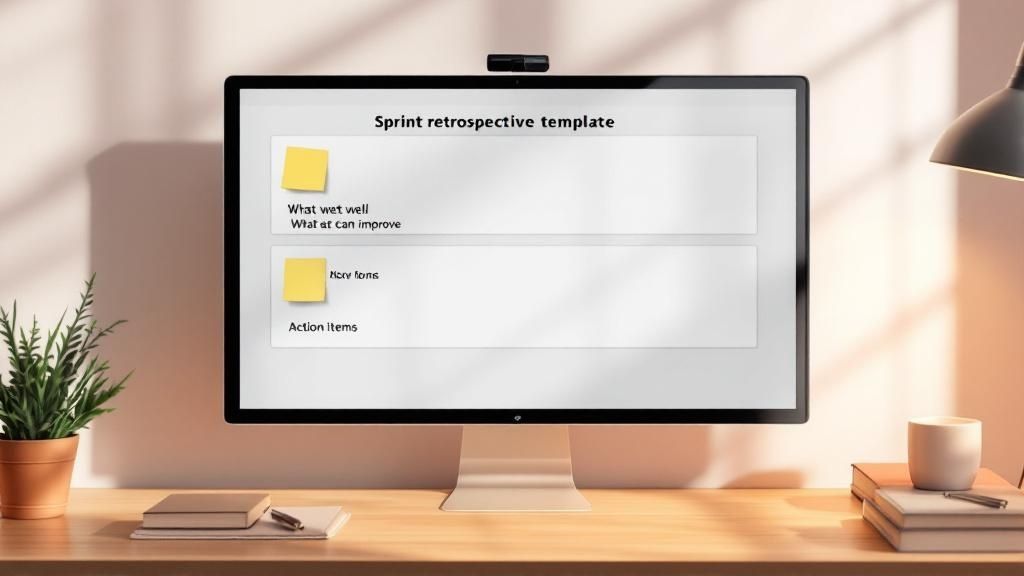A Sprint Retrospective Template That Actually Works
Tired of retros that go nowhere? Use our sprint retrospective template and guide to facilitate meetings that drive real, continuous improvement for your team.
A great sprint retrospective template can fix a broken process, but only if you understand why the process is broken in the first place. Too often, these meetings become a low-energy ritual instead of the engine for real improvement they're meant to be.
Why Most Sprint Retrospectives Fail to Deliver
Let's be honest—many sprint retrospectives feel like a complete waste of time. They kick off with the best intentions but quickly spiral into the same circular conversations, sprint after sprint. If your retros are falling flat, you're not alone. It's a common frustration for teams that are genuinely trying to get better.
Before diving into a new template, it’s worth a quick refresher on the fundamental concepts of a Retrospective. This ceremony is designed to be a powerful engine for progress, but it frequently stalls out for a few key reasons.
Common Failure Points
Several recurring issues can turn this valuable meeting into a dreaded obligation. See if any of these sound familiar:
- There’s No Psychological Safety: Team members won't share candid feedback if they fear being blamed or sparking conflict. The moment criticism is taken personally, people clam up, and the most valuable insights stay buried.
- The Conversations are Repetitive and Unfocused: Without a clear framework, discussions get stuck on the same few topics. Often, one or two dominant voices take over the conversation, and quieter team members never get a chance to contribute their perspective.
- Nothing Actually Happens Afterward: This is the biggest demotivator of all. A retrospective that generates great ideas but no action items is just a talking shop. When the team sees their suggestions disappear into a void, they stop believing in the process.
The goal isn't just to talk about what happened; it's to create small, deliberate changes that make the next sprint better. Without that focus on action, the retrospective becomes a hollow exercise.
Ultimately, these meetings fail when they lack a clear purpose and a structure that encourages both safety and accountability. This vicious cycle of ineffective meetings is exactly why so many teams go searching for new continuous improvement frameworks and a better sprint retrospective template to shake things up.
Your Customizable Sprint Retrospective Template
Let's get one thing straight: a rigid, one-size-fits-all retrospective is a recipe for a stale meeting. The most effective templates are flexible. They adapt to your team’s specific needs and the unique chaos of the last sprint. I’m not going to hand you a strict script. Instead, here’s a framework built around three core phases that guide a natural flow from reflection to action.
This process isn't just about talking; it's about moving from gathering data to creating concrete, tangible action items.

This simple progression is powerful. It’s what ensures your discussions actually translate into measurable improvements for the next sprint, instead of just fading away.
The Three Phases of an Actionable Retrospective
You can wrap this structure around almost any popular retrospective format. Whether your team loves the simplicity of 'Start-Stop-Continue,' the nuance of the '4Ls (Liked, Learned, Lacked, Longed For),' or a more creative approach like the 'Sailboat' metaphor, this three-phase flow provides the backbone. It helps you tailor the meeting to where your team is right now. If you're looking to dive deeper, Umano Tech has a great piece on how to boost your Agile meetings.
To help you visualize how this works in practice, here's a quick breakdown of the template's structure.
Sprint Retrospective Template Breakdown
This table outlines each phase, its core purpose, and some questions you can use to get the conversation started.
| Phase | Objective | Example Prompts |
|---|---|---|
| Set the Stage | Create a safe, focused environment where everyone feels comfortable sharing openly. | "On a scale of 1-5, how did you feel about the last sprint?"<br>"What's one word that describes your experience with this sprint?"<br>"Let's quickly review our action items from the last retro—what was the outcome?" |
| Gather Data & Insights | Build a shared, multi-perspective understanding of the sprint without judgment. | "What gave us momentum? Where did we see a real win?"<br>"Where did we hit a wall or lose energy?"<br>"What was the most surprising thing we learned?"<br>"Let's group these notes—do we see any patterns emerging here?" |
| Decide What to Do | Convert insights into a small, focused set of measurable action items. | "Of all these themes, which one would have the biggest positive impact if we fixed it?"<br>"What is one small experiment we can try in the next sprint to address this?"<br>"Who will own this action item, and what does 'done' look like?" |
This framework keeps the meeting moving forward, ensuring you leave with clarity and purpose.
Phase 1: Set The Stage (5–10 minutes)
The goal here is simple: create a safe, focused space. Kick things off with a quick check-in or a simple icebreaker to get everyone present and engaged. This is also the moment to reiterate the retrospective's prime directive: "Regardless of what we discover, we understand and truly believe that everyone did the best job they could, given what they knew at the time, their skills and abilities, the resources available, and the situation at hand." This sets a blameless tone from the start.
Phase 2: Gather Data & Generate Insights (25–30 minutes)
This is the heart of the retro. The mission is to build a shared picture of the sprint from everyone’s point of view. Crucially, avoid jumping straight to solutions. First, just collect the data points without judgment.
- What Went Well? Celebrate the wins, big and small. What gave the team energy?
- What Presented a Challenge? Identify the friction points, blockers, and frustrations. Where did we get stuck?
- What Did We Learn? Uncover the surprises, new knowledge, or unexpected outcomes.
Once you have a good collection of thoughts, start grouping similar items into themes. This is the magic step where you move from individual comments to collective insights. Look for patterns, dependencies, and the real root causes hiding beneath the surface.
Phase 3: Decide What To Do (10–15 minutes)
With clear insights on the board, the final step is to forge them into actionable, measurable improvement items. Whatever you do, don't try to solve everything at once.
Select one or two high-impact improvements to focus on in the next sprint. Overcommitting is a classic failure point that leads to inaction and cynicism about the whole process.
For each action item, assign a clear owner and define what "done" actually looks like. This isn’t about blame; it's about accountability and making it easy to check on progress in the next retrospective. When the team leaves with concrete steps, the meeting becomes a catalyst for genuine, continuous improvement.
Laying the Groundwork for a Great Retrospective
A truly effective retrospective doesn’t just happen when the meeting starts. The real magic, the stuff that separates a candid, productive session from a silent, awkward one, is all in the prep work you do beforehand.
Success isn't about booking a room or dropping a calendar invite. It’s about intentionally setting the psychological stage for honesty.

This all kicks off with some clear, thoughtful communication. A day or two before the retro, send out a quick message that frames the purpose. Make it clear this isn't a performance review—it's a collaborative problem-solving session designed to make the next sprint better for everyone.
Priming the Team for Honesty
Your goal here is to get people thinking without giving them homework. Just a gentle nudge to get their minds reflecting on the past sprint can make all the difference.
- Share the Template: Send a link to the sprint retrospective template you plan to use. This simple step removes any mystery and lets the team know exactly what to expect.
- Pose Gentle Questions: In your reminder, drop in a couple of light prompts. Something like, "Start thinking about one thing that gave you energy and one thing that drained it last sprint." It's low-pressure but effective.
- Emphasize Safety: This is non-negotiable. Explicitly state that the meeting is a "blame-free zone." You have to reinforce that the focus is on improving processes, not pointing fingers at people.
An effective retrospective hinges on psychological safety. When team members trust that their honest feedback will be met with respect and curiosity—not defensiveness—they are far more likely to share the insights that lead to real breakthroughs.
Even with a perfect template, the biggest challenge is making the improvements stick. Teams often struggle to track whether the small changes agreed upon in the retrospective are actually making a difference.
This is where SprintDojo bridges the gap between insight and action. It solves this by combining daily win celebrations, weekly team reviews, and AI-powered forecasting into one alignment system. Research shows small wins are the #1 motivator for sustained team performance (Amabile & Kramer, 2011), and SprintDojo builds this into your team’s daily rhythm, making progress visible and keeping everyone aligned.
Facilitating Retrospectives That Drive Engagement
A great facilitator can be the difference between a retrospective that feels like a chore and one that becomes the team's engine for improvement. Your job isn't to have all the answers. It’s to guide the conversation, protect the clock, and make damn sure every single voice is heard.
Effective facilitation is all about creating a psychologically safe space. When tough topics come up—and they should—your role is to steer the conversation toward systems, not blame. You're the one who gently redirects a conversation that’s drifting off course and brings it back to what matters.

Drawing Out Crucial Insights
One of your biggest challenges will be engaging the quieter folks on the team. Their insights are often gold, but they can easily get steamrolled in a loud, free-for-all discussion.
Here are a couple of simple but powerful techniques to try:
- Silent Brainstorming: Give everyone five minutes to jot down their thoughts on sticky notes before anyone says a word. This levels the playing field instantly.
- Round-Robin Sharing: Go around the room (virtual or physical) and ask each person to share just one idea. It ensures participation without putting anyone on the spot.
To get to that next level of honest feedback, you have to build trust. You can pull ideas from powerful team building exercises to foster the kind of rapport needed for real talk. This is the bedrock of a strong team culture, which is a whole topic in itself.
In fact, you can learn more about how to do that by checking out our guide on https://sprintdojo.com/articles/how-to-build-team-culture.
Don't underestimate the impact of this. The numbers are clear: teams that run retrospectives consistently show a 24% increase in responsiveness and a massive 42% improvement in quality. These aren't just vanity metrics; they show how these meetings directly boost a team's agility and the stability of what they ship.
A skilled facilitator doesn't lead the team to a conclusion. They create an environment where the team discovers the best conclusion for themselves. It's all about active listening and asking the right questions.
From Insight to Action: How to Make Retrospectives Actually Stick
Let's be honest. A retro can generate a mountain of brilliant ideas, but those insights are completely worthless if they never leave the meeting room. The biggest failure of most retrospectives isn’t a lack of good ideas; it’s the complete absence of follow-through.
This is where the real work begins. Turning discussion into tangible change is the final, crucial step. To get real value, you need effective strategies to streamline business processes that turn those insights into reality. Without this, the entire exercise feels pointless, and your team's morale takes a nosedive.

Creating Lasting Accountability
The key is to escape the trap of "we should do this" and get to a concrete "who, what, and when." Every single action item must be specific, measurable, and tied to a single owner.
- Prioritize Ruthlessly: You can't fix everything at once. Don't even try. Use a quick dot-voting exercise to let the team pick the one or two improvements that will deliver the biggest punch.
- Assign Clear Ownership: Every action item needs a champion. This isn’t about assigning blame; it's about giving someone the responsibility to keep that item from getting lost in the shuffle.
- Define "Done": What does success actually look like? Make the outcome crystal clear and verifiable. "Improve code reviews" is a wish. "Create and share a code review checklist by Wednesday" is an action.
This constant visibility is what drives real change. To dig deeper into what makes these small habits stick, check out these proven behavioral change techniques that can help your team turn retrospective actions into lasting improvements.
Common Retrospective Questions Answered
Even the slickest retrospective template runs into real-world friction. Questions always come up. Here’s how I’ve learned to handle the most common curveballs teams face when they’re trying to get better.
How Do I Make This Work for a Remote or Hybrid Team?
When your team is spread out, you have to shift your thinking from a single meeting to a two-part process: async prep and a highly focused live session.
-
Prep asynchronously. A day before the retro, drop the prompts into a shared digital space like Miro or Mural. Let everyone add their notes on their own time. This is a game-changer for teams across different time zones, ensuring nobody’s great idea gets lost because they were offline.
-
Facilitate visually. By the time the meeting starts, the board should already be populated with ideas. The facilitator's job isn't to pull teeth—it's to guide a conversation around what’s already there. Use timers and keep the energy high. The live session is for discussion and decisions, not quiet data entry.
What If My Team Is Disengaged or Silent?
Crickets during a retrospective are usually a symptom of a deeper issue, like low psychological safety or just plain old retro fatigue.
First, always kick things off by restating the "prime directive"—we're here to improve the system, not to point fingers. This can take the pressure off. Then, try a technique like silent brainstorming. Give everyone five minutes to write down their thoughts before anyone speaks. This gives the introverts a chance to contribute and prevents the loudest voices from dominating.
The number one cause of disengagement? A history of inaction. If the action items from the last three retrospectives disappeared into a black hole, people learn that their input doesn't matter. The fastest way to re-engage a team is to show them that their feedback leads to real, tangible change.
A 2025 study on meeting practices found something fascinating: while most teams track metrics, a whopping 60-70% don't actually use that data effectively in their retrospectives. They're stuck in basic spreadsheets. You can dig into the full findings on retrospective data usage here. This reveals a massive gap between collecting info and using it to find deep insights. If you want to fix disengagement, start making data-driven improvements a core part of the conversation. It proves the meeting isn’t just talk—it’s about making smarter decisions.
Sprint Smarter. Forecast Every Week.
Log wins. Build momentum. Let AI show you if you're on track to hit your sprint goal—before it's too late.
Join the waitlist and be the first to unlock predictive clarity for your team.

